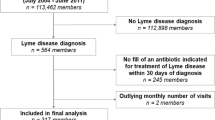Abstract
This study examined how often physicians in Georgia diagnose and treat Lyme disease as well as the criteria they use to reach a diagnosis of Lyme disease. A survey was sent to 1,331 family physicians in Georgia concerning how many cases of Lyme disease the physicians diagnosed, and the criteria used to make the diagnosis, during the preceding 12 months. Of 710 responses, 167 physicians treated 316 cases of Lyme disease without a firm diagnosis. In addition, 125 physicians diagnosed 262 cases of Lyme disease, 130 without serologic testing and 132 with serologic testing. Family Physicians in Georgia diagnose Lyme disease at a rate 40 times greater than the surveillance case rate reported in Georgia.
Similar content being viewed by others
REFERENCES
Lyme Disease--United States, 1999. MMWR 2001; 50(10):181–185.
Lyme Disease--United States, 1996. MMWR 1997; 46(23):531–535.
Orloski KA, Hayes EB, Campbell GL, Dennis DT. Surveillance for Lyme disease--United States, 1992–1998. MMWR 2000; 49(SS03):1–11.
Case definitions for infectious conditions under public health surveillance. MMWR 1997; 46(RR-10):20–21.
Tick-borne diseases in Georgia. Georgia Epidemilogy Report 2000; 16:1–4.
Tick bites and erythema migrans in Georgia: it might not be Lyme disease! Georgia Epidemiology Report 2001;17:1–4.
Nichol G, Dennis DT, Steere AC, et al. Test-treatment strategies for patients suspected of having Lyme disease: a cost-effectiveness analysis. Ann Intern Med 1998; 128:37–48.
Tugwell P, Dennis DT, Weinstein A, et al. Clinical guideline, part 1: guidelines for laboratory evaluation in the diagnosis of Lyme disease. Ann Intern Med 1997; 127:1106–1108.
Tugwell P, Dennis DT, Weinstein A, et al. Clinical guideline, part 2: laboratory evaluation in the diagnosis of Lyme disease. Ann Intern Med 1997; 127:1109–1123.
Sigal LH. TheLyme diseasecontrove rsy. Social and financial costs of misdiagnosis and mismanagement. Arch Intern Med 1996; 156:1493–1500.
Reid MC, Schoen RT, Evans J, Rosenberg JC, Horwitz RI. The consequences of over-diagnosis and over-treatment of Lyme disease: an observational study. Ann Intern Med 1998; 128:354–362.
Shapiro ED, Gerber MA. Lyme disease. Clin Infect Dis 2000; 31:533–542.
Luckhart S, Mullen GR, Wright JC. Etiologic agent of Lyme disease, Borrelia burgdorferi, detected in ticks (Acari: Ixodidae) collected at a focus in Alabama.J Med Entomol 1991; 28:652–657.
Oliver JH, Chandler FW, James AM, Huey LO, Vogel GN, Sanders FH. Unusual strain of Borrelia burgdorferi isolated in Ixodes dentatus in central Georgia. J Parasitol 1996; 82:936–940.
Oliver JH, Chandler FW, James AM, et al. Natural occurrence and characterization of the Lyme disease spirochete, Borrelia burgdorferi, in cotton rats (Sigmodon hispidus) from Georgia and Florida. J Parasitol 1995; 81:30–36.
Barbour AG. Does Lyme disease occur in the south? A survey of emerging tick-borne infections in there gion. Am J Med Sci 1996; 311:34–40.
Dennis DT, Nekomoto TS, Victor JC, Paul WS. Piesman, J. Reported distribution of Ixodes scapularis and Ixodes pacificus (Acari: Ixodidae) in the United States. J Med Entomol 1998; 35:629–638.
Oliver, JH. Lyme borreliosis in the southeastern United States: a review. J Parasitol 1996; 82: 926–935.
Seltzer EG, Gerber MA, Cartter ML, Freudigman K, Shapiro ED. Long-term outcomes of persons with Lyme disease. JAMA 2000; 283:609–616.
Nadelman RB, Wormser GP. Erythema migrans and early Lyme disease. Am J Med 1995; 98(suppl 4A):15S–23S.
Keenan GF. Lyme disease: diagnosis & management. Compr Ther 1998; 24:147–152.
Georgia Epidemiology Report. Georgia Division of Public Health 2001;17: 4.
Georgia Department of Community Health's Board for Physician Workforce. Available at: http://mdworkforce.mercer.edu.
Feder HM, Whitaker DL, Hoss DM. The truth about erythema migrans. Arch Dermatol 1997; 133: 93–94.
Malane MS, Grant-Kels JM, Feder HM, Lugar SW. Diagnosis of Lyme disease based on dermatologic manifestations. Ann Intern Med 1991; 114:490–498.
Campbell GL, Fritz CL, Fish D, Nowakowski J, Nadelman RB, Wormser GP. Estimation of the incidence of Lyme disease. Am J Epidemiol 1998; 148(10):1018–1026.
Young JD. Under-reporting of Lyme disease. N Engl J Med 1998; 338:1629.
Physician reporting of Lyme disease--Connecticut, 1991–1992. MMWR 1993; 42:348–350.
Feder HM, Whitaker DL. Misdiagnosis of erythema migrans. Am J Med 1995; 99:412–419.
Svenungsson B, Lindh G. Lyme borreliosis--an over-diagnosed disease? Infection 1997; 25:140–143.
Burdge DR, O'Hanlon DP. Experience at a referral center for patients with suspected Lyme disease in an area of nonendemicity: first 65 patients. Clin Infect Dis 1993; 16:558–560.
Brown SL, Hansen SL, Langone JJ.Role of serology in the diagnosis of Lyme disease. JAMA 1999; 282:62–66.
Masters EJ, Girardeau C. Erythema migrans in the south. Arch Intern Med 1998; 158:2162–2165.
Kirkland KB, Klimko TB, Meriwether RA, et al. Erythema migrans-like rash illness at a camp in North Carolina. Arch Intern Med 1997; 157:2635–2641.
Steere AC. Lyme disease. N Engl J Med 2001; 345:115–125.
Verdon ME, Sigal LH. Recognition and management of Lyme disease. Am Fam Physician 1997; 56:439–440.
Author information
Authors and Affiliations
Corresponding author
Rights and permissions
About this article
Cite this article
Boltri, J.M., Hash, R.B. & Vogel, R.L. Patterns of Lyme Disease Diagnosis and Treatment by Family Physicians in a Southeastern State. Journal of Community Health 27, 395–402 (2002). https://doi.org/10.1023/A:1020697017543
Issue Date:
DOI: https://doi.org/10.1023/A:1020697017543




